CPVC and PVC pipes both move water and share other characteristics, but only one is used in fire protection
Since its first use in fire protection systems in the 1980s, chlorinated polyvinyl chloride (CPVC) pipes have emerged as a corrosion-resistant, lighter weight, less expensive, longer-lasting alternative to metal pipes in residential and light hazard wet sprinklers. And while steel has traditionally dominated the market, CPVC fire sprinkler pipe’s unique advantages have it rapidly gaining share.
Previously, we’ve weighed the benefits of CPVC against other pipe materials for residential uses, and taken a hard look at the pros and cons of CPVC and another nonmetallic material popular in residential fire sprinklers: cross-linked polyethylene (PEX).
In this blog, we clear up any confusion between CPVC vs PVC (polyvinyl chloride), the thermoplastic material popular in plumbing and drainage solutions but not approved for fire protection systems.
Feel free to check out our selection of CPVC pipe fittings and glue.
PVC 101: the history of nonmetallic pipe
Commonly used to create plumbing pipes and fittings, PVC is a man-made, plastic polymer material comprised of 57 percent chlorine and 43 percent carbon. The chlorine comes from industrial-grade salt and the carbon is derived from oil or gas ethylene.
PVC was accidentally synthesized by a German chemist in the late 19th century, appearing as a white solid inside a flask of vinyl chloride gas that had been left exposed to sunlight. But it wasn’t until 1925 that an industrial scientist at BFGoodrich stumbled upon a way to make PVC useful. While looking for a way to bond metal to rubber, he instead discovered how to make PVC elastic and moldable, paving the way for commercial applications such as electric-wire insulations, fabric coatings, and shock-absorber seals.
After World War II, American sewage, drainage, and water distribution enterprises became intrigued with PVC piping used in Europe, drawn to its ability to resist rust and rot. But it was the scarcity of metal after the Korean War ended that cemented the popularity of thermoplastic pipes in the U.S., causing PVC to stand out as a durable and affordable alternative in the 1950s.
Today, the material’s strength, reliability, relatively low cost, and ease of use have led to the installation of more than two million miles of PVC pipe throughout North America. PVC pipes enjoy an average lifespan of 50 years or longer, with most reasons for failure boiling down to manufacturing defects or improper usages such as poorly glued joints, over-pressurization, or exposure to incompatible chemicals.
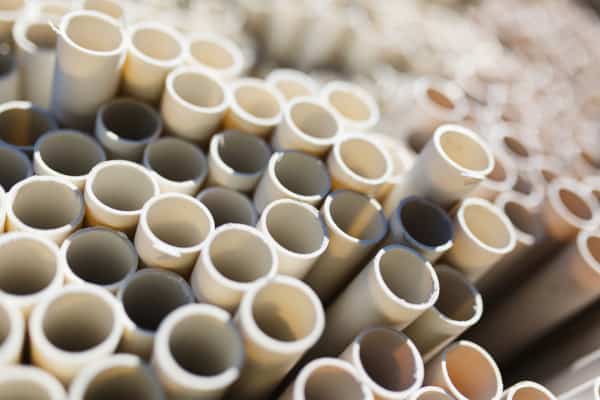
CPVC vs PVC: So, what’s really different?
PVC has a major drawback: its use is limited to colder-water applications because it can only withstand temperatures of 140°F before it risks softening, cracks, or leaks that can cause pipe or joint failures. So, in 1959, BFGoodrich Performance Materials (now Lubrizol Corp.) pioneered the first CPVC pipes, offering a corrosion-resistant alternative to traditional metallic piping systems that could also handle hotter temperatures.
The difference is right there in the name: chlorinated polyvinyl chloride.
In the world of chemical science, a single, small change to a molecular structure can have a huge impact on how a material behaves in real-world situations. PVC and CPVC are made of the same basic elements with one difference: CPVC manufacturers take strong, moldable PVC and alter it with a free radical chlorination reaction, boosting its chlorine content from 57 percent to as high as 74 percent.
The chart below demonstrates a typical CPVC engineering and production process:
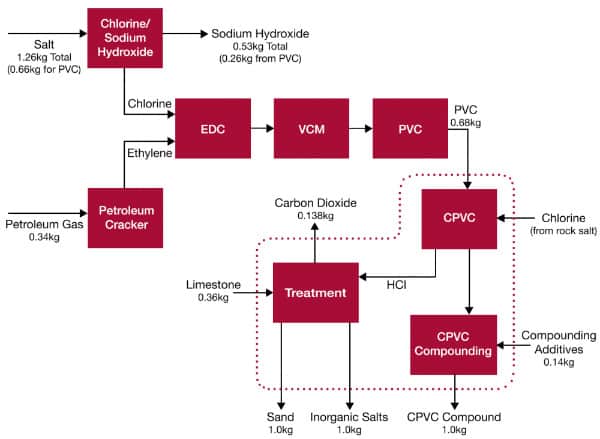
Essentially, the process involves bombarding PVC material with UV radiation, causing hydrogen molecules to be displaced by chlorine ions. The increased chlorine content protects the polymer’s carbon backbone, enabling CPVC pipes to withstand temperatures as high as 200°F before beginning to soften. Even so, NFPA 13: Standard for the Installation of Sprinkler Systems (A.7.3.2) notes that the upper service temperature of currently listed CPVC sprinkler pipe is 150°F (65.5°C) at 175 psi (12.1 bar).
The bigger chlorine atoms also physically block oxidants and chemicals from attacking the CPVC chain structure, enhancing its inherent resistance to degradation. After the CPVC resin is formed, it can be infused with additives that also boost other protective properties, such as UV resistance.
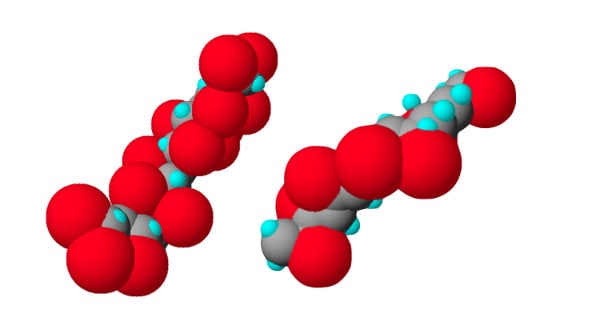
CPVC vs PVC: The practical differences
Like PVC, CPVC is a thermoplastic material that can be easily molded into different shapes to create pipes, fittings, valves, and other liquid-handling supplies. CPVC shares PVC’s other compelling characteristics as well: it’s impact-resistant, sturdy, doesn’t corrode like metal, and resists degradation from chemicals classified as acid, alkali, or inorganic material. These pipes also have innate insulation that reduces condensation and helps maintain water temperature.
A slick, impermeable surface keeps bacterial contamination at bay in both pipes, although the extra chlorine in CPVC adds an additional layer of protection. Deposits are also less likely to cling to the smooth surface and clog these pipes, keeping flow characteristics high and increasing energy efficiency.
CPVC mirrors PVC’s longevity as well: the first CPVC piping systems installed in 1959 remain in service 60 years later, although the average lifespan is 50 years. They can be sized differently: PVC pipe uses nominal pipe size, which measures the diameter of the interior hole, and CPVC relies on nominal size or copper tube size, which references the outside diameter of the tube.
CPVC is more expensive, but both materials are cheaper than metal pipes. They are also available in similar lengths and end-shape options. In fact, PVC and CPVC look so similar that manufacturers use different colors to tell them apart. The CPVC pipe and fittings used in fire sprinkler systems is orange.
The unique advantages of CPVC for fire sprinklers
The first CPVC pipes and fittings targeted hot-water residential plumbing applications. But it wasn’t long before manufacturers realized that the greater resistance to heat from added chlorine also made CPVC perfect for the fire protection market.
CPVC material maintains a flash ignition temperature of 900°F (482°C), which is the lowest temperature at which sufficient combustible gas can be ignited by a small external flame. PVC pipe carries a flash ignition temperature of only 750°F (399°C). In comparison, many ordinary combustibles such as wood ignite at 500°F or less.
CPVC material also maintains a Limiting Oxygen Index (LOI) of 60, meaning it needs 60 percent oxygen in its surrounding atmosphere to sustain a flame. Since the Earth’s atmosphere only contains 21 percent oxygen, CPVC must be forced to burn, and stops smoldering as soon as the blaze is removed. Instead, a charring layer forms on the outside of the pipe when it comes in direct contact with fire, creating a thermal barrier that reduces heat conduction into the pipe and enables the inside to remain smooth, so flame-retarding water can continue to flow quickly. CPVC produces low smoke development and no burning drops as well, so it won’t spread a fire.
Watch this video to see how BlazeMaster CPVC pipes performed during UL (formerly Underwriter Laboratories) fire testing:
CPVC’s inherent immunity to corrosion is also a game-changer for the fire protection industry, which struggles with leaks, obstructions, and system failures caused by rust and microbiologically influenced corrosion (MIC) in metal pipes. More than 70 percent of dry sprinkler systems suffer significant corrosion issues within 12.5 years of installation, and 35 percent of wet sprinklers experience major problems after 25 years.
Even so, the first CPVC sprinkler system faced an uphill battle when it hit the market in 1984 under the BlazeMaster brand. Some property owners were wary of using plastic for fire protection, convinced that it would simply melt or burn like many other plastics when confronted with flames.
Extensive testing and approval from the respected safety organization UL slowly extinguished fears that CPVC pipes would fall apart during a large fire. Aggressive marketing campaigns also emphasized the material’s lower cost, easy handling due to its light weight, and faster, safer installation because joints are assembled by hand using a compound that chemically welds them together—without flame or heavy equipment. The faster installation generally leads to labor-cost savings as well.
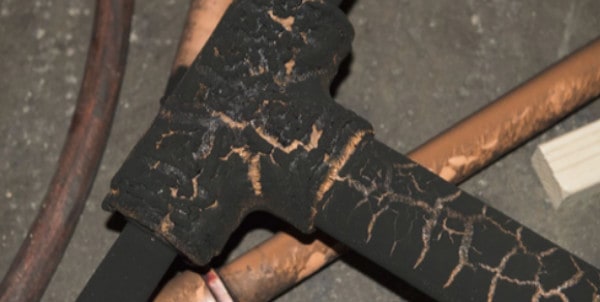
Not all CPVC is created equal
The National Fire Protection Association (NFPA) allows the use of CPVC pipe in sprinklers for single- and multi-family housing and other light hazard occupancies where fires tend to develop slower with lower heat, including churches, schools, nursing homes, and offices. It can also be used in rooms rated “ordinary hazard” that are smaller than 400 square feet and within an otherwise light-hazard setting, such as kitchens in an institutional facility. CPVC is NFPA-approved for some underground piping and air plenums as well. These latter spaces facilitate air circulation for heating and air conditioning systems in a building.
But read this carefully: manufacturers may use different compounds to produce CPVC pipe and fittings. And many are specially engineered for the fire sprinkler market. Different resins and additives can yield different performance, so it’s important to research the manufacturer’s reputation and testing protocol before deciding which pipe to use. Fire sprinkler contractors now have access to a range of quality, brand-name products designed specifically for sprinkler system installations. These include BlazeMaster®, TFI, FlameGuard™, and FireLock™.

CPVC is not listed for use in exposed outdoor settings, as prolonged exposure to sunlight can impact its strength. It is also not recommended for commercial dry systems since it can become brittle at cold temperatures, creating a serious safety hazard if the energy of the pressurized gas is released suddenly due to a pipe rupture. That said, Tyco does carry a UL-listed, CPVC-based dry pipe system for residential occupancies. It serves as a viable option for homeowners who leave their homes without climate control for lengthy stretches of time.
Another caveat: CPVC sprinkler pipes and fittings are listed to UL 1821, the standard for thermoplastic pipe and fittings for fire protection service—but not all CPVC pipes and components are listed for the same exact use in fire sprinkler systems. It’s essential for contractors to confirm via the manufacturer that a product they want to install is not only listed for fire sprinklers but also for the specific application within the system.
While BlazeMaster, TFI, FlameGuard, and FireLock CPVC are all listed for sprinklers, BlazeMaster CPVC has a different manufacturing process that gives it an American Society for Testing and Materials (ASTM) 06 rating vs. the ASTM 05 rating of other brands. This means it has 25% greater estimated long-term strength, or hydrostatic design pressure, and is slightly less likely to burst at higher temperatures. This difference and the fact that it’s been tested and listed in specific ways means Blazemaster has slightly broader applications in unfinished basements in NFPA 13D installations, for example. You can read about that and whether it makes a difference in your installation in our previous blog: “CPVC Pipe and Fittings in Fire Sprinkler Systems: Use and Care.”
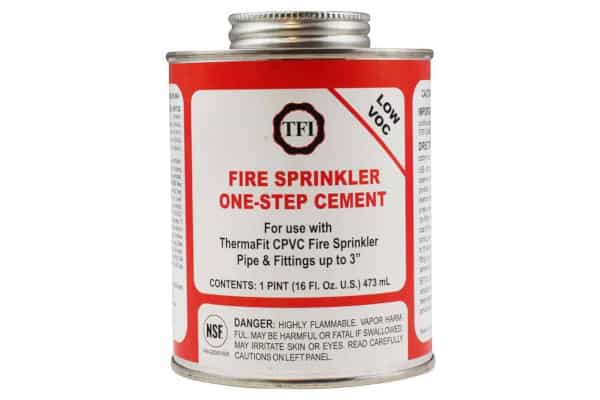
Also note that while PVC and CPVC pipes may look similar, the differences in their chemical makeup prevent their primers, solvent cements, and bonding agents from being used interchangeably. The creation of a strong joint depends on the cement’s ability to chemically soften the plastic. For instance, CPVC solvent cements must meet ASTM F493 specifications, and PVC solvent cements must adhere to ASTM D2564. There are also different requirements based on the pipe’s size and intended application, so it’s imperative to check the product container to ensure you matched it correctly.
CPVC builds on the benefits of PVC for reliable fire protection
Metal’s strength, durability, and resistance to extreme heat established it as the material of choice in the fire protection industry, but its susceptibility to corrosion and surging cost pose challenges. Less-costly CPVC pipe shares the many benefits of PVC plus has temperature resistance—offering the fire protection industry a piping option with lower costs, easier installation, significantly less chance of corrosion, and less friction for flowing water than traditional metal pipes.
Ready to start shopping for CPVC pipe components? Browse our selection of CPVC pipe fittings and glue. Questions about QRFS products or need a brand or item not in our online inventory? Just call us at +1 (888) 361-6662 or email support@qrfs.com.
This blog was originally posted at blog.qrfs.com. If this article helped you understand the evolution of CPVC pipes for fire sprinkler systems, check us out at Facebook.com/QuickResponseFireSupply or on Twitter @QuickResponseFS.
Source for the image at the top of this post: International Fire Protection magazine


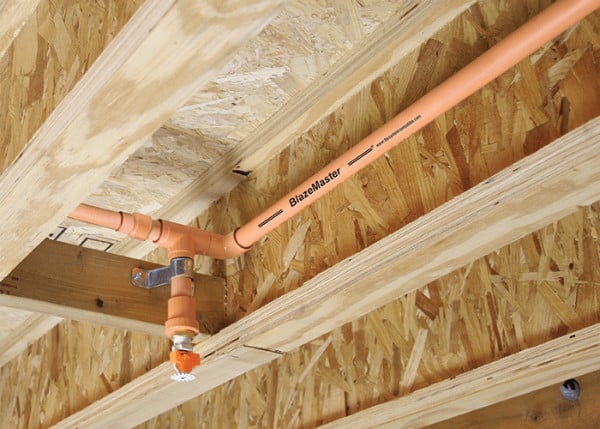
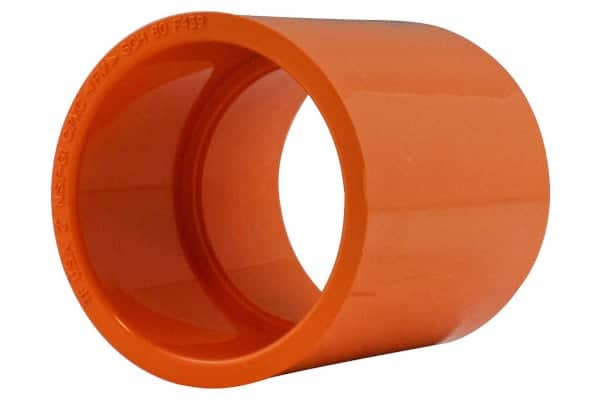
Thanks for sharing information.Your blog has always been a source of great tips.
There are various benefits of using PVC, pipes firstly they are lightweight, making its installation easier with minimum manpower, where installing a metal pipe might demand a lot of manpower and working hours leading towards increasing the cost. Secondly, PVC pipes are extremely flexible, and possess the ability to yield under loading without fracturing. However, when it comes to selecting a pipe it is best to consult a plumbing company before you proceed forward with the purchase.
Jenn — This is true for plumbing installations. But fire protection applications require CPVC (or another approved thermoplastic) for above-ground system pipe in specific applications.
Recent inspection of a 4-story residential building new construction reveals sprinkler pipe connections (Ts and elbows) are grey and the pipe is orange. Is there a potential issue?
John — Potentially, yes. CPVC or PVC can both be grey (CPVC is usually a lighter grey). And if it’s PVC, the connections do not have the fire resistance of CPVC, and are not NFPA 13 approved for use in fire area settings. Even if they are made of CPVC, orange CPVC brands are specifically made for fire protection, with tested thermal resistance, etc.
i want to know how we can give sprinkler piping in room for fire safety
Thank you ronak fire nitin -8451080815
Nitin — Can you clarify what you need? The pipe itself or are you looking for info on how to install pipe? Thanks.
Our house has had fire sprinklers put in when it was remodeled 6 years ago on Friday one of the sprinklers split and flooded my house and it was this kind of piping is there some sort of guarantee from the makers of this piping? Sure seems it should have lasted longer than 6 years now it’s making me worried about the rest of the piping not to mention a pretty expensive remodel to my property after this.
Joan — If a “sprinkler split” that isn’t the piping that failed. If the pipe itself cracked, yes, that’s unusual. You should check with your manufacturer to see if there is a warranty and review potential causes. If the pipe was damaged in any way (like a hard hit) or came into contact with certain chemicals it could be more prone to failure. Best of luck.
At my condo complex, a neighbors sprinkler pipe recently burst and flooded their house. Building is about 16-17 years old. The fire sprinkler people who came afterwards to fix said “it had a crack probably from being stepped on during installation”. Huh? a 16-year old crack bursting for no apparent reason? The residents had said they heard a loud pop. I would think a crack might have been leaking over the years but no evidence of that.
Hope your insurance company took care of it for you. And hope our condo master insurance premiums don’t skyrocket from this claim.
Wendy — CPVC pipes that take a hard hit might weaken over time and eventually (suddenly) fail, which is why the manufacturers have specific instructions to handle the pipes carefully. And we hope your insurance stays steady as well! If the issue stems from an installation problem, they might not.
Another awesome article. Very detailed and informative. Thanks for sharing!
Can I use CPVC piping for sprinkler system located on propylene spheres in industries
Navinchandra — We’re not sure we fully understand the latter part of the question. But you can only use CPVC pipe that is specifically tested and listed for use in fire protection systems, as it is assessed for its heat resistance and other factors. CPVC used in fire protection is orange in color and comes from specific suppliers. Further, it is only applicable in certain environments—light-hazard and residential applications.
Can a homeowner purchase fire protection CPVC pipe and fittings? (without a license)
Yes, a homeowner can certainly purchase them. We would not recommend installing pipe and fittings (certainly not designing a system) without appropriate fire protection qualifications, however!
The developer of my neighborhood in San Diego County, CA had PVC fire sprinkler systems installed back in the mid to late 80’s. In Calif, when did CPVC become required? And then, was it mandatory to replace these PVC systems with CPVC? And if not, what is the trigger for having to do so? Thanks.
Phil — Honestly, we can’t answer your question, as we are unaware of fire sprinkler systems ever being officially allowed to use PVC, which does not have the temperature tolerances required for fire protection. CPVC first became available for use in fire protection systems in 1984, and the rules for where and when it can be used have evolved since. Unfortunately, it’s likely a PVC-based system will need replacement, but you should consult with your local authority having jurisdiction.
When CPVC pipe is run within a building but outside the thermal envelope of the building for example in a loft space, what is the recommended level of thermal insulation required to protect from freezing where the outside temperature may drop to as low as -10 Celsius. Does CPVC pipe have improved thermal characteristics over copper or steel pipe?
Michael — We cannot recommend a “level of thermal insulation required to protect from freezing” at a given temperature in this forum. Your best bet is to contact the manufacturer to answer both questions—and a local fire protection pro to address insulation—though we are comfortable saying that CPVC does not have noteworthy cold-resistance benefits (but listed fire protection CPVC does have improved heat resistance). Best of luck and thanks for reading.
Thanks for sharing. Very detailed information.